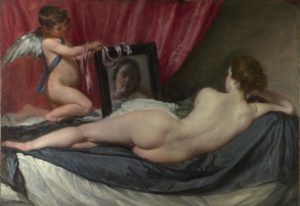With the dozens of climate protests at museums over the past several years, many are inclined to see activists’ vandalism of prominent artworks as a fairly modern concept. Last month, someone threw soup at a Monet while others taped photos over the protective glass on Botticelli’s Birth of Venus. However, many would probably be surprised to learn that today marks the hundredth anniversary of one of the most famous examples of such protest. Even when mass media was in its infancy, some people already understood how to use it, including an activist in Britain named Mary Richardson.
On March 10, 1914, Richardson walked into London’s National Gallery. On display that day was a painting by Diego Velázquez popularly known as the Rokeby Venus. It is the only female nude Velázquez created that still survives today. When Richardson got close, she pulled out a meat cleaver and repeatedly began hacking, creating a series of large slashes across the canvas. In a prewritten statement published in The Times the following day, Richardson confessed that her actions were in support of the Women’s Social and Political Union (WSPU), the leading women’s suffrage organization in Britain. The fight for women’s suffrage in Britain was far more turbulent than in the United States. American women’s organizations prioritized respectability, while British suffragettes increasingly took part in direct action. When suffragettes were imprisoned for their protests, they often went on hunger strikes, leading to them being forced fed, a method now considered a form of torture by some medical bodies. By 1912, suffragettes began to protest more severely, initiating a campaign of bombings across the country; targeting government buildings, churches, and even private homes. They started by bombing the homes of three cabinet ministers as well as the Home Secretary’s office. They also tried to set fire to the Theatre Royal in Dublin during a matinée performance while Prime Minister H.H. Asquith was in attendance.
Richardson’s stunt caused the Royal Academy and the Tate Gallery to close temporarily. Women were not allowed to enter the British Museum unless a man accompanied them. Despite increased security, four months after the initial incident, another suffragette named Anne Hunt entered the National Portrait Gallery and used a cleaver to deface John Everett Millais’s portrait of Thomas Carlyle.
While Richardson damaged the Velázquez to draw attention to the women’s suffrage movement in general, the act was likely provoked by the recent arrest of WSPU founder Emmeline Pankhurst the day before. Richardson wrote, “I have tried to destroy the picture of the most beautiful woman in mythological history as a protest against the Government for destroying Mrs. Pankhurst, who is the most beautiful character in modern history.” Richardson was branded in the newspapers as “Slasher Mary”. Activists in Britain seem to remember the Rokeby Venus as a symbol of protest. Just this past November, as Mary Richardson had done, climate protestors entered the National Gallery and used hammers to smash the layer of protective glass covering the Rokeby Venus. Just Stop Oil, the organization responsible for many of these recent incidents, wrote in a statement, “Politics is failing us. It failed women in 1914, and it is failing us now.” Writing for Forbes, Alexandra Bregman astutely observed the connection between today’s climate activists and the suffragettes of a century ago. She also offered a degree of uncertainty about the effectiveness of these tactics: “Whether the splashers of today will implement the same progress as the slashers of yesterday remains to be seen, but their place in history will never be forgotten.”

